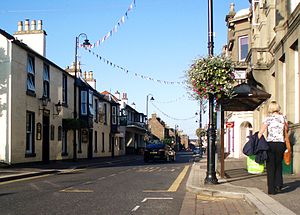Battle of Barry
| Battle of Barry | |||||||
|---|---|---|---|---|---|---|---|
 Carnoustie High Street, traditional site of the Battle of Barry |
|||||||
|
|||||||
| Belligerents | |||||||
| Scots | Danes | ||||||
| Commanders and leaders | |||||||
| Malcolm II | Camus | ||||||
Coordinates: 56°30′04″N 2°42′30″W / 56.5011°N 2.7083°W
The Battle of Barry is a legendary battle in which the Scots, purportedly led by Malcolm II, defeated a Danish invasion force in 1010 AD. Its supposed site in Carnoustie, Angus can be seen in early Ordnance Survey maps. The history of the event relies heavily on tradition and it is currently considered to be apocryphal. The battle was named for the Parish of Barry, rather than the village, and was formerly thought to have taken place at the mouth of the Lochty burn, in the vicinity of the area that is now occupied by Carnoustie High Street. While the battle is not historically authentic, its romantic appeal continues to capture the popular imagination.
The account of the battle was first recorded by sixteenth century Scots historian, Hector Boece.
Boece informs us that Sueno, king of Denmark and England, unhappy with news of his army's defeat at Mortlach, ordered a naval task force to set sail for Scotland. Part of the force was to sail from Denmark, and the rest from the Thames, both under the command of Camus.
According to the legendary account, the army camped at St Abb's Head for several days before sailing north, landing at Lunan Bay in Angus. After sacking Montrose, the Army headed inland and razed the town of Brechin to the ground. Camus received word that King Malcolm II had brought the Scots army to Dundee and ordered the Danish army to march South, reaching the coast near to Panbride. The Scots army set camp at Barry, two miles to the West.
...
Wikipedia
